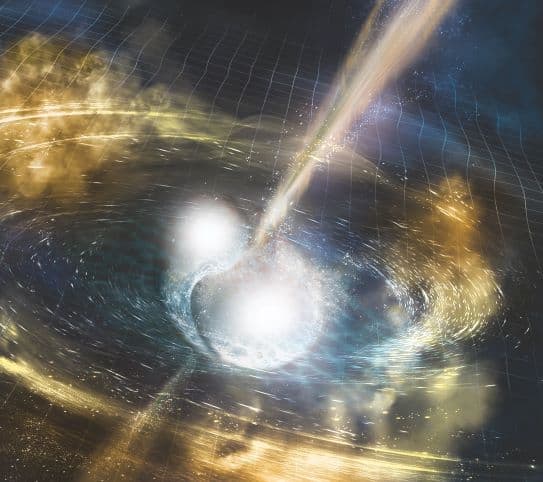
Physicists have created a framework for better understanding the super-dense matter inside neutron stars by combining observations from gravitational-wave detectors and conventional telescopes with experimental results from particle accelerators.
The results, from a team led by Sabrina Huth of Technische Universität Darmstadt in Germany and Tsun Ho (Peter) Pang of Utrecht University in The Netherlands, indicate that many neutron stars experience greater degeneracy pressure in their interiors than predicted. As a consequence, some neutron stars have a larger-than-expected radius – a result that was previously hinted at in observations by the Neutron Star Interior Composition Explorer Mission (NICER) experiment on board the International Space Station.
Neutron stars are among the most extreme objects in the universe. They are the crushed cores of stars that have exploded as supernovae, and despite measuring only around 20 kilometres across, they pack in a mass up to 2.3 times that of the Sun. Inside them, the pressure is so great that negatively charged electrons and positively charged protons are crushed together, forming a body made almost entirely from neutrally charged neutrons.
The term “degeneracy pressure” refers to the inability of any two particles – in this case, neutrons – to inhabit the same energy level when crushed together. This inability produces a countervailing outward pressure that works to prevent neutron stars from being smushed any further. “Therefore, for high pressures, neutrons want to be farther apart, resulting in a larger neutron star,” Pang explains.
Equation of state
Knowing the radius of neutron stars will help astrophysicists constrain the stars’ so-called equation of state, which describes the properties of matter inside a neutron star and therefore dictates its radius. Since nobody knows exactly what the equation of state is, Huth and Pang’s team ran through 15 000 possible versions of it in their modelling, inputting data from several spinning neutron stars known as pulsars as well as gravitational-wave observations of two mergers between two neutron stars. These included the merger known as GW170817, which hit the headlines in 2017 when it was detected by the LIGO gravitational-wave detector and by telescopes observing at wavelengths across the electromagnetic spectrum. As such, it heralded the dawn of multimessenger astronomy.
The latest study took the multimessenger approach still further by incorporating information from collisions between gold ions accelerated to almost the speed of light. These collisions take place at high temperatures and low densities – unlike space, where temperatures are low but the density of objects like neutron stars is high. By combining the results of collisions at several particle accelerators (including the GSI Helmholtz Centre for Heavy Ion Research in Darmstadt as well as Lawrence Berkeley National Laboratory and Brookhaven National Laboratory in the US) with astrophysical observations, it is possible to begin bridging the gap in our understanding of matter in extreme environments.
“Because the data from heavy-ion collisions used in our analysis gives us information about the density region where nuclear theory and astrophysical observations are less sensitive, it provides us with a novel constraint [on the equation of state],” Pang says.
Afterglow consequences
The results also add to scientists’ understanding of what happens during a neutron star merger. In such events, two neutron stars orbiting in close proximity gradually spiral towards one another. As they begin to merge, gravity deforms their shape. This deformation shows up in the gravitational waves they emit during the merger, and is dependent upon the mass and radius of the neutron stars. A neutron star with a larger radius will be less compact and have weaker gravity, which can affect how much debris gets ejected by the merger. It is this glowing debris that is detectable in light as a “kilonova”, so the quantity of debris and its properties determines how visible a kilonova will be.
Nicolás Yunes, an astrophysicist at the University of Illinois at Urbana-Champaign, US, who was not involved in the latest research but who has previously used multi-messenger observations to discern properties of neutron-star matter, thinks we should anticipate more such results in the future. “Multimessenger astronomy is truly transformative and is already having an impact on our understanding of the state of matter at extreme densities and pressures,” he says.

Nobel prize heralds new era of multimessenger astronomy
With an upgraded version of LIGO (Advanced LIGO) expected to pick up gravitational waves from many more binary neutron-star mergers, at greater levels of sensitivity, and NICER continuing to provide independent measurements of the radii of pulsars, astrophysicists should soon be able to place even stronger bounds on the equation of state for neutron stars. “By combining information at high temperatures but low densities with information at low temperatures but high densities, we will begin to learn precisely how matter behaves in the universe,” Yunes concludes.
The research is published in Nature.



